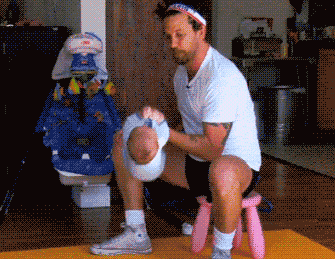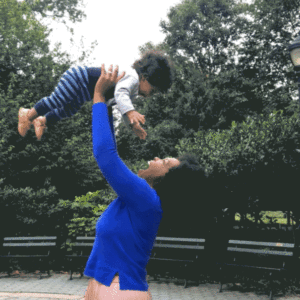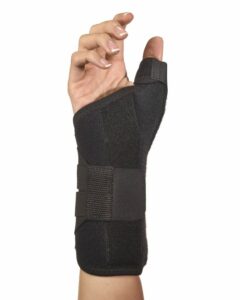
Do you have wrist pain? Do you have thumb pain? Do you have thumby-wrist pain?
Often, people with De Quervain’s Syndrome can’t decide if it’s their thumb that hurts, their wrist that hurts, or both. And truthfully, that makes a lot of sense – here’s why:
Now I’m sure some of you are thinking “whoa, whoa, whoa, back up a minute – De-what Syndrome?” Good point – let’s start there.
De Quervain’s Syndrome is the layman’s name for “tenosynovitis of the extensor pollicis brevis (EPB) and the abductor pollicis longus (APL) tendons”. I’m sure that cleared things up, right? – probably not. So let’s dig a little deeper.
Relevant Anatomy in De Quervain’s Syndrome

The two labelled tendons in this picture are the ones to take note of when thinking about De Quervain’s Syndrome (in case you’re wondering, the unlabelled tendon is the extensor pollicis longus). As you can see, the tendons have a “synovial sheath” wrapped around them (indicted by the red-pink coloured sausage-looking structures in this photo).
Then, the tendons travel underneath a piece of connective tissue called the extensor retinaculum (looks like a white piece of tape over the tendon sheaths in the above photo). Essentially, the tendon’s travel through a tunnel on the thumb side of the wrist, and the tendon sheaths are designed to decrease friction and improve gliding/mobility. Now let’s clarify some terms:
Tenosynovitis: “teno” = tendon; “syno” = sheath”, “itis”= “inflammation”; thus, tenosynovitis means inflammation of a tendon’s synovial sheath. In the case of De Quervain’s Syndrome, the inflamed tendon sheaths belong to the extensor pollicis brevis (EPB) and the abductor pollicis longus (APL) muscles. Hopefully that clears up why De Quervain’s syndrome is technically a “tenosynovitis of the extensor pollicis brevis (EPB) and the abductor pollicis longus (APL) tendons”
Extensor pollicis brevis (EPB): “extensor” = muscle that extends; “pollicis” = thumb; “brevis” = brief, or short; thus, the EPB is a muscle that attaches to thumb and runs into the forearm. It’s main action is to extend the thumb (give a “thumbs up”), and it ends a little earlier in the forearm than it’s partner, the extensor pollicis longus (EPL).
Abductor pollicis longus (APL): “abductor” = muscle that abducts; “pollicis” = thumb; “longus” = longer; thus, the APL is a muscle that attaches to thumb and runs into the forearm. It’s main action is to abduct the thumb (place your palm facing the ceiling, then point your thumb at your nose – that’s thumb abduction)

De Quervain: the last name of the Swiss surgeon who first identified this condition in 1895.
Syndrome: a collection of symptoms that typically occur together (more of the symptoms of De Quervain’s in a second).
Hopefully this clears up what De Quervain’s Syndrome is. In short, thumb tendons and their tendon sheaths are irritated/inflamed.
Common Signs and Symptoms of De Quervain’s Syndrome
De Quervain’s syndrome is most commonly a “chronic overuse” injury, in that prolonged, or repetitive use of the APL/EPB muscles eventually leads to inflammation and pain. That said, a direct trauma to the area, or inflammatory arthritis may also predispose this condition. It is significantly more common in women (often postpartum), most commonly between the ages of 30 and 50.
Pain: along the thumb side of the hand and wrist. May radiate up the forearm during activity.
Swelling and tenderness to touch: over the tendon sheath on the thumb side of the wrist.

children, or use of smart phone for scrolling or typing.
Common actions: gripping, pinching, wringing, or grasping of objects with affected hand
Positive Finkelstein Test: a provocation test in which you tuck your thumb in your palm and make a fist (with thumb side of hand up). Holding the thumb in the hand, bend hand downward. Like this:
Due to the variety of actions/activities that may lead to De Quervain’s syndrome, there has been a long list of (somewhat hilarious) layman’s names given to this syndrome including:
- BlackBerry Thumb
- Texting Thumb
- Gamer’s Thumb
- Mother’s Wrist
- Mommy’s Thumb
A little side note: I often treat this condition in postpartum women on maternity leave. I attribute this primarily to the new task of lifting up a baby constantly and consistently throughout all hours of the day and night (think of the position the hands are in when you pick up a baby under their armpits). The secondary component often being a little extra smartphone time while off work/at home on maternity leave. Scrolling and clicking…
How to Fix De Quervain’s Syndrome
See a physiotherapist: a physiotherapist is trained to assess, diagnose, and treat your individual situation. That way, they can provide you with a tailored treatment program of bracing (if necessary), modalities/hands on therapy, and home exercises designed to get you back to 100% as quickly as possible. In the meantime, read on for some helpful hints.
Relative rest: ideally, try to limit all aggravating activities, and let the tendons rest/relax. If it’s not possible to rest enough, or if pain is significant, it’s worthwhile to get a brace. The brace can help prevent excessive use of the thumb. They look something like this:
Flossing the tendons: pretend you’re fishing! Start with your elbow bent so that your relaxed hand is near your shoulder, thumb side of your hand pointing upward. Slowly straighten your elbow while also placing your thumb on top of your fist, and gently bending your hand down (like you’re casting a fishing rod).
Strengthen the tendons: as it becomes comfortable to work the tendons, you’ll want to slowly and progressively strengthen them to ensure a full recovery. This will also help to reduce the likelihood of reinjury.
Here’s a couple examples:
1. Thumb extension with elastic band:
- Wrap an elastic band around your hand, and tuck your thumb under the band.
- Give a “thumbs up”, then lower back down.
- Repeat 10 times, and complete 1-2 sets, 1-2 times per day
2. Thumb abduction with elastic band:
- Wrap an elastic band around your hand, and tuck your thumb under the band. Hold your palm facing upward
- Move your thumb to point it at your nose, then return to the starting position.
- Repeat 10 times, and complete 1-2 sets, 1-2 times per day
Conclusion
That thumb-wrist pain you have may quite possibly be De Quervain’s Syndrome, and hopefully this blog post has helped you understand more about what that even means. Not sure if you have De Quervain’s Syndrome, or concerned about your wrist pain in general? Want to get out of pain, and back to function?
The best thing to do is to see a physiotherapist and get your individual situation assessed as soon as possible.
At Strive Physiotherapy & Performance, we are committed to providing an in-depth assessment to ensure we can work together to find the best plan of action for each individual client.
Call us at 519-895-2020, or use our online booking tool on www.strivept.ca to book an appointment with one of our knowledgeable physiotherapists, and they will be sure to help you understand your injury.
Take good care,
Tyler Allen
Physiotherapist at Strive Physiotherapy & Performance




